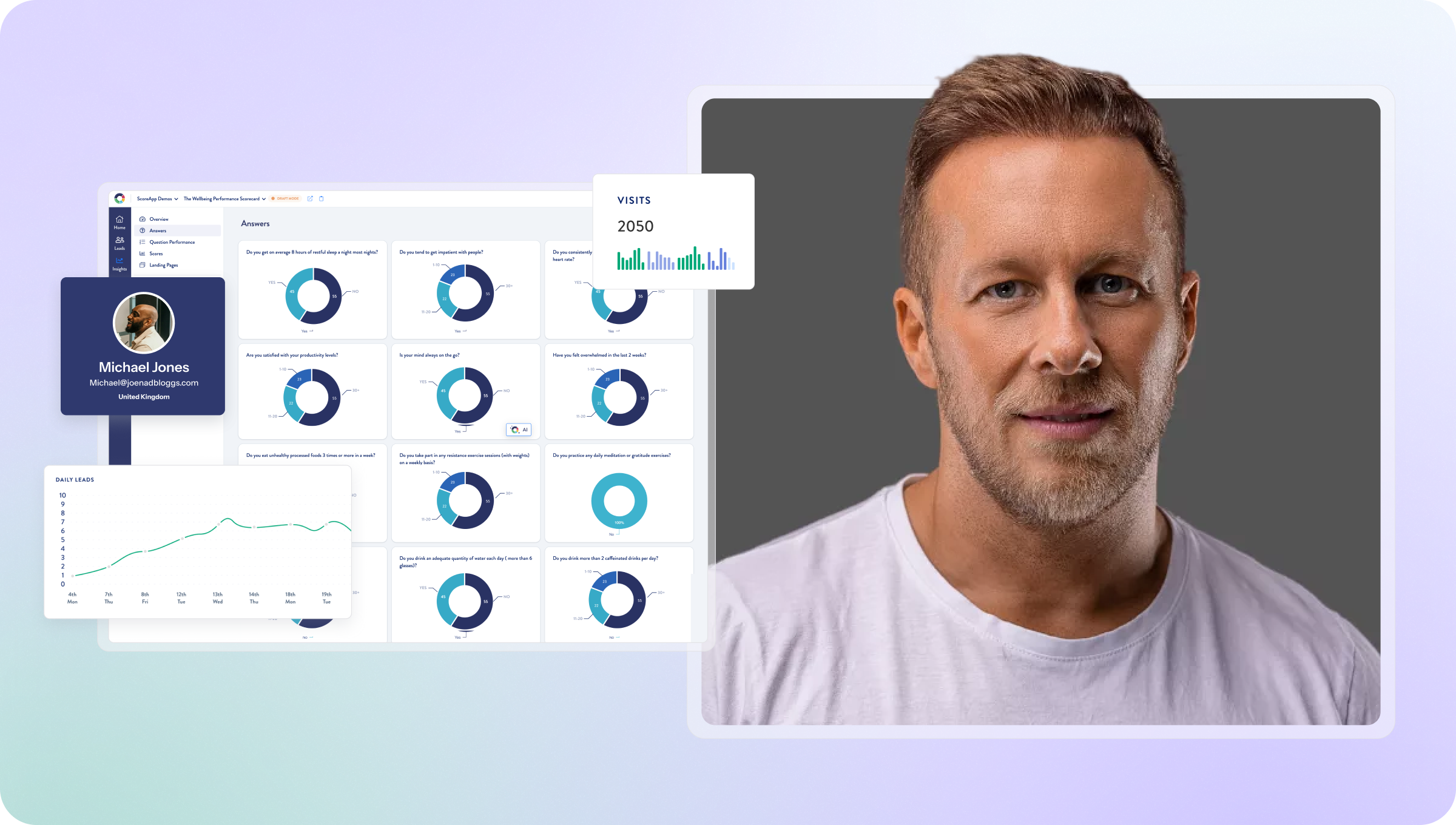
Everything in business flows from lead generation. It’s a critical foundation for your business strategy because it directly impacts your ability to attract the right customers and grow your sales pipeline.
A simple truth: No leads = no customers = no sales = no revenue = no business.
Luckily, the much more appealing opposite is also true!
Qualified leads = good customers = more sales = increasing revenue = thriving business
As with anything worthwhile, investing in the preparation phase prevents poor performance. Here are some of the main elements you need to consider as you lay the groundwork of your lead generation strategy – and how ScoreApp safely scaffolds your process.
Set your lead generation goals
What are your business goals? You need to identify your short- and long-term business aims, as your lead generation goals are part of your strategy to meet these overarching business aims. So you can’t define one without first getting clarity about the other.
Types of lead generation goals
When you’re ready with your business goals, there are two main types of lead generation goals to consider:
- Quantitative goal: Your ‘how many?’ metrics. This includes things like the number of leads from each sales funnel campaign and conversion rates from different CTAs.
You might set a quantitative goal like: ‘Increase email subscribers by 40% by the end of the next quarter.’
- Qualitative goals: Considering more nuanced elements like customer engagement and the quality of leads. As a goal, this might look like: ‘Increase the number of pre-qualified leads by 25% over the next 3 months.’
Bake success into your strategy
The trick with goal-setting is to make them measurable, attainable, and aspirational. Doing some maths makes it easier to make sense of your goals.
For example:
- Decide on a target number of new customers you want to sign up
- Divide this by your current conversion rate
- This is how many bottom of the funnel sales conversations (and conversions!) you need to meet your target with your current sales strategy
In numbers:
- You want 10 new clients
- Your average current conversion rate is 10%
- 10 ÷ 0.10 = 100
- You need to convert 100 sales conversations to secure those 10 new clients
An expertly crafted lead generation campaign will help you reduce the number of prospect conversations you need to convert by highly targeting messaging to only your ideal clients – sending you only high-quality, pre-qualified leads.
Whether you choose to measure conversion rate, cost per lead or lead quality, your metrics give you a way to understand what’s working, what’s not, and the ROI for your campaigns.
Before you start your lead generation strategy, you need to be clear about what you’re measuring, how you’re measuring it, and what success looks like in numbers.
Resourcing your lead generation strategy
You need appropriately trained staff, the right tech stack, and all the necessary resources and tools before kick-off. And before you can put any of that in place, you need to define your budget for lead generation activities.
It needs to be a realistic figure that allows you to see a campaign all the way through, monitor all the key metrics, and optimise your strategy based on their insights.
Make sure everyone’s aiming for the same net!
You need to share your goals with your whole organisation. While marketing and sales teams will be the most hands-on, a shared vision keeps everyone focused on the most important goals.
This is also the time to be very explicit about team spirit. Lead generation strategy is a continuous ‘test and learn’ cycle. There’s no ‘one and done’ set formula. This needs to be everyone’s expectation at the start – from the sales team to the boardroom.
Being open about the results of lead generation campaigns means that you’ll always learn something and be alert to improvements. Yes, each campaign stands alone, with a set timeframe. But refining all the nuances of your customer knowledge into actions takes time. Success is asking key questions, no matter what the results, because you see the importance of constant learning.
- The results weren’t what we wanted, so what can we try instead?
- What do we know about why customers at the bottom of the funnel didn’t convert? What reassurances can we put in place next time?
- Why did those clients buy from us? Not just a celebration of success here, but a dive into why – what are we doing differently to our competitors? Is this something we didn’t already know?
You need to lead this attitude of experimentation, highlight the importance of analysis and reflection and applaud optimistic curiosity in your creative minds.
Test, analyse, think, change, try again – this is what a successful lead generation strategy looks like in practice. ScoreApp generates insightful reports from your analytics, with a range of data features that inform evidence-based decision-making.
Understand your target audience
A lead is someone who’s started the conversation with your company by giving their information in exchange for something immediately useful. But do you know what’s going to be useful to them? Do you know what analogies and cultural references will resonate? Do you know how they’ll feel when your product or service fixes their problem?
There’s a whole treasure trove of information available you can use to attract your ideal customers.
Defining factors: Who are they?
Demographic research involves gathering all the key data points about your prospective clients.
Demographics can include: Age, geographical location, gender, race, religion, marital status, income level, education, occupation, and their role within the buying team. You need to decide which statistics are useful in your business context.
Motivators: What’s important to them?
There are so many factors that influence someone’s decision-making. It’s useful to track and analyse as many of them as possible, so you can build a comprehensive set of brand personas.
These psychographics include: Social status, opinions, lifestyle, personality, interests, values, and beliefs. Segmenting your audience into groups based on shared psychographic traits can be an extremely potent way to develop resonant messaging.
Specifics: Why are they buying?
Figuring out your audiences’ buyer behaviour characteristics is an invaluable way to make sure you design the perfect customer journey for each of them. Consider questions like:
- What problems are they trying to solve with your product or service – specifically?
- What’s their exact pain point? How does this make them feel?
- What job do they need to get done?
- What are their decision criteria? How does this differ between members of the same buying team?
- How will the benefits of your offering make them feel?
- What’s their ambition, their aspiration beyond the ‘fix?’
- What worries might they have about the purchase? Alleviate these barriers as quickly as possible.
It’s up to you to get into their heads, even before you develop your service or manufacture your product. You can build that pre-launch product market fit by using a ScoreApp waitlist to get a feel for your prospective audience before you invest time and resources into development.
Know your offer and unique selling proposition (USP)

You need a clear overview of the entire competitive landscape and understand where you sit among your competitors. The deeper you understand your competition’s offering, the more able you are to distinguish your point of difference – and superiority!
Don’t be shy. This doesn’t mean trashing your industry colleagues, just absolute clarity about how your product or service is unlike other companies and how it’s simply better.
This connects to how your offering addresses your prospects’ pain points and needs while adding a layer of nuance. For example, your waitlist market research reveals that customers are unhappy that your main competitor’s new product doesn’t have a key feature that had been widely requested. So you highlight the fact that you’ve listened to customer feedback and their great idea is part of your new launch.
Choose the right lead generation channels for your business
No supermarket would go rogue and put the toilet roll in the bakery aisle – no one would ever find it! But sometimes it’s helpful when they have the meringues next to the strawberries and cream, or the buns beside the burgers.
If you understand how your customers shop, you’ll know which lead generation channels to invest in. You need to know how your customers find your product or service – and be there at the right time. The brand personas you’ve created from your intensive customer research are invaluable here.
Where are your customers hanging out and when will they be most receptive to your conversations?
Online lead generation channels
ScoreApp quizzes can be integrated into a whole host of different online channels.
- Social media: From traditional LinkedIn to the newest arrival, social media quizzes are excellent lead generation tools. You just need to know which platforms your ideal customers are using.
- SEO and PPC: Get ahead of the game and use quizzes to power your SEO strategy and PPC plan.
- Email marketing: Use quizzes as part of your email marketing campaign to help you reap insights from your current list and grow subscribers.
- Content marketing: Quiz funnels are a secret weapon in your content marketing strategy.
Offline lead generation channels
Of course, there are all the IRL channels where you can meet your audience, well, in real life! Event quizzes can be a great way to generate leads at industry events and trade shows, at different points of your audiences’ experience.
Other offline channels include direct mail – yes, snail mail still counts! – billboards, radio ads, print spots, TV commercials, leaflets, brochures, and product sampling.
Your choice of lead generation channel all goes back to how well you know your target. You’re not expecting them to come to you, you’re going to put yourself right in front of their faces wherever they are. As with all things lead generation, you may have to test different methods before you find the best one for your audiences.
Create a high-quality and engaging lead magnet
We’re all more aware of the value of our data to the companies we share it with. That means you need to offer prospects something immediately useful to them in exchange for their contact details.
Traditionally, this includes things like a downloadable eBook, webinar, discount, free trial, and calculator tools. And all of these lead magnet ideas can be valuable to your customers. Either relevant information presented in an engaging way, or actual money off. How many of these have you tested already? Are there any that just wouldn’t be appropriate in your industry?
ScoreApp lead generation quizzes add an extra dimension for your audience and your business. They’re even more magnetic to prospects because they give personalised reports with immediately actionable insights, based on their answers to the questions. You gather amazing amounts of information, not just contact details, but their needs, pain points, and opinions about the competition.
ScoreApp quizzes make excellent lead magnets because immediate participation creates a stronger connection with leads. And they really couldn’t be easier to set up – minimum time and resources investment, maximum magnetism and market research insights.
Set up landing pages for lead capture
Landing pages are a key factor in your lead generation strategy because they focus visitors on one decision – they either take that next step or leave the page altogether.
ScoreApp landing page templates take the hassle out of the design process. We built them with all the ingredients for success baked in Each landing page should include:
- One focus on one offering – no menus, links or other distractions
- Clear CTA in an obvious button
- Concise forms that gather essential information
- Compelling copy: our templates have example copy that you can use to scaffold your own unique messaging
- Social proof section as an option within the template designs
- Image library to select a strong visual to support your copy
- Fast loading speeds
- Fully optimised for mobile devices
It can be overwhelming to wade through all the available landing page builder options ScoreApp makes the whole process much less time consuming, you can completely customise your landing pages, A/B test different versions to see what converts best, and it integrates smoothly with the rest of your techstack.
Choose the best lead generation tools and systems for your needs

The Hubspot ‘State of Marketing 2024’ is full of statistics like ‘AI-powered personalisation in marketing emails can increase ROI by up to 70%.’ Quite the statement, isn’t it? And there’s ever-growing evidence that software tools and systems are improving lead generation exponentially.
Choosing the best lead generation tools for your business can be tricky – there are so many on the market.
- Marketing automation software automates those nurturing email campaigns that move leads through the sales funnel – as well as other useful workflows
- CRM systems manage and track all your leads in one place that your whole team can be access
- Analytics tools that measure and evaluate the effectiveness of your lead generation campaigns – some, down to each individual element.
Just like any flatpack furniture assembly – you need to get all your tools together before you start lead generation. ScoreApp integrates smoothly with a range of CRMs, email marketing and other tools.
Plan a lead nurturing strategy
Great! Your potential customer clicked on an ad that led to your carefully crafted landing page and either entered their details or hit ‘buy.’ Now what?
‘Initiate nurturing sequence’ (Starfleet captain voice), that’s what. You need a communications sequence to match all the various scenarios your visitor’s actions can trigger. For example, they put something in their shopping basket but then clicked off before securing the purchase. Send an email with a 10% off code to tempt them back.
With all the insights from your brand personas market research and continual monitoring of your lead gen data, you can personalise your email streams to perfectly fit each audience segment. You can confidently lead your prospects through to the next stage of the sales funnel.
Consider compliance and privacy rules

Keep up to date with current data protection laws to ensure your entire lead generation process is fully compliant with data protection regulations. Not just UK GDPR, but evolving rules around online privacy that vary from country to country.
You must have clear communication about getting explicit consent to hold client information and how you’re going to use that data. ScoreApp has this crucial legal requirement built in.
Consistently optimise your lead generation process
Remember, lead generation isn’t just a ‘set it up once and off we go’ process. You need to put regular times in your diary to analyse and optimise your system.
You established your KPIs and measuring tools right at the start, so your lead gen builder is constantly tracking your chosen metrics. But the numbers by themselves aren’t useful. You need to regularly evaluate your insight reports to understand the performance of your lead generation campaigns.
This also gives you the opportunity to fully optimise every stage of your lead generation funnel. Every tiny tweak that makes your communication more effective increases the number of high-quality leads in your pipeline – and cash in your bank account.
Create a robust lead generation strategy with ScoreApp
So, that’s your full lead generation planning checklist. Yes, there’s a lot to consider. But time and thought now is the wise way to maximise your time and resources investment.
Want to get on with waitlist market research, designing a quiz, or lead gen optimised landing page? Get started with ScoreApp, for free!




